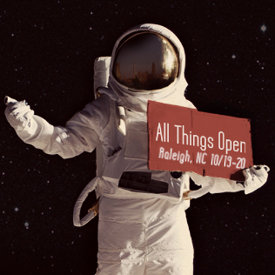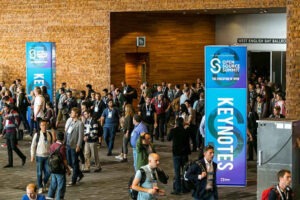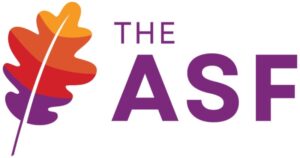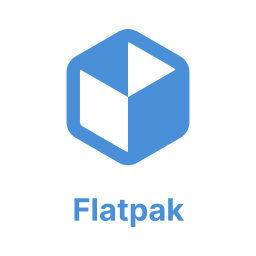The 2015 edition of the Raleigh based open source conference, All Things Open (ATO), is now one for the history books. It’s also one for the record books.
We knew going in there would be a record number of speakers this year — 131 according to a count on the ATO website — and we learned on our way out — at the closing ceremonies — that this year’s attendance topped 1,700, much more than last year and nearly doubling the attendance from the first ATO in 2013. Todd Lewis, the master of ceremonies for the event — his official title, chairperson, doesn’t begin to describe what he does — said that next year they’re aiming for 2,500, a number they probably have a good chance of hitting.
 The odd thing was that if you didn’t know that attendance was up, you might’ve thought that the numbers were actually going down. That’s mainly because IT-oLogy, the folks behind the event, spent some extra bucks and rented the entire second floor of the Raleigh Convention Center, which gave them a whopping thirteen meeting rooms to use for presentations, plus the third floor Grand Ballroom — large enough to hold a Learjet, with room left over for a Cessna or two — for the keynote addresses. The later addition meant that the keynotes were no longer SRO, with plenty of room for attendees to spread themselves out and get comfortable.
The odd thing was that if you didn’t know that attendance was up, you might’ve thought that the numbers were actually going down. That’s mainly because IT-oLogy, the folks behind the event, spent some extra bucks and rented the entire second floor of the Raleigh Convention Center, which gave them a whopping thirteen meeting rooms to use for presentations, plus the third floor Grand Ballroom — large enough to hold a Learjet, with room left over for a Cessna or two — for the keynote addresses. The later addition meant that the keynotes were no longer SRO, with plenty of room for attendees to spread themselves out and get comfortable.
So how good were the workshops? Unfortunately, I can only tell you about the few I attended, all of which get a thumbs up. Here’s my mini-reviews of some of those I attended, in no particular order:
- Tarus Balog, the head honcho at OpenNMS was at ATO to give a presentation called, “Living an Open Source Life.” I’d met Balog earlier this year at Charlotte’s SouthEast LinuxFest (SELF), where he did a talk called “Open Source Is Dead,” which was quite entertaining. I figured the ATO talk would be about the same, but it turns out that Balog isn’t a one trick pony when it comes to conference presentations. Basically, this was an entry level intoduction to free software and tech freedom.
Balog spent his 40 minute hour explaining why folks should consider using open source, and took his audience through the process of choosing a Linux distro, while explaining some of the software choices that would be available for them afterwards — even going so far as explaining the hows and whys of replacing Android with one of the open versions of the mobile OS. It was a great workshop — and something like it should be required at every Linux or open source conference.
-
The open source tech writer that people either love or love to hate, Steven J. Vaughan-Nichols, was back with his presentation with the rather long-winded title: “How and Why Open Source Projects Can Use Marketing and Work with the Press.” This workshop is a must for any open source project that’s seeking to get some press attention. SJVN pulls no punches while explaining the news media in all of its glory and ugliness, or as much as possible in 40 minutes. It’s guaranteed that if you pay close attention to what he says, you’ll be on the road to getting the attention your project deserves.
-
Another presentation with an overly long title was “Setting Your Code Free (Without Scaring the Lawyers): Licensing & IP Considerations When Doing Code Releases and Contributions.” Here, the long title is somewhat understandable as it was written by a lawyer.
Here, Heather Meeker, a partner in O’Melveny & Myers’ Silicon Valley office and a member of the Mergers and Acquisitions practice group, took her audience through the legal issues that companies and individuals should consider when deciding on whether or not to open source code — and she spoke in plain English and left the lawyer talk in her office. I learned a lot — like, one of the reasons a company might not want to open source code is if it utilizes a patent the company holds — because that might make enforcing that patent difficult. ‘Nuff said?
-
“Many Ways to Move the Needle on Open Source” was another excellent workshop, conducted by Guy Martin with Autodesk and Nithya Ruff with SanDisk. This workshop was totally different than what I expected.
The pair talked about all of the necessities of running a successful open source project, interspersed with stories of their own experiences. They point out that a successful project requires more than the mere writing of code and includes development, marketing, advocacy and community management. In one interesting aside, Ruff talks about a meeting she had with Microsoft CEO Satya Nadella a few weeks before the conference, during which she thanked him for using open source. “But the truth is,” she added, “open source is everywhere and you can’t escape it.” In other words, he has no choice but to use open source.
Anyway, there was too much in this workshop to cover in a couple of paragraphs, so we’ll have more on this later.
This year’s conference also had a different feel that the two previous ATOs. It felt less regimented, more laid-back and comfortable, with more of an atmosphere you might expect from a community conference than a big tent enterprise event. When I mentioned this in passing to Todd Lewis, he said he’d noticed that too, but wasn’t sure why. Perhaps, he suggested, it was the layout for this year’s show. With everything happening on the same level and with less crowding, folks didn’t have to remain intent on pushing their way through to the next presentation and could stop and smell the roses — or visit with the vendors.
Or, it could be that now established, the event can now relax into itself. There’s nothing to prove anymore: It’s a great conference and that’s all there is to it.
Christine Hall has been a journalist since 1971. In 2001, she began writing a weekly consumer computer column and started covering Linux and FOSS in 2002 after making the switch to GNU/Linux. Follow her on Twitter: @BrideOfLinux







That is what you get for stilling the show!